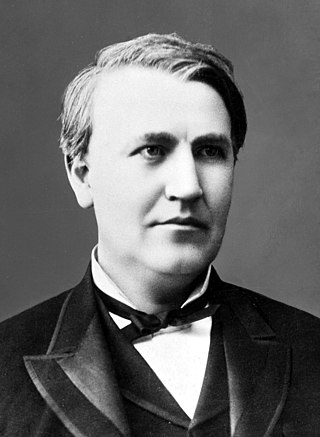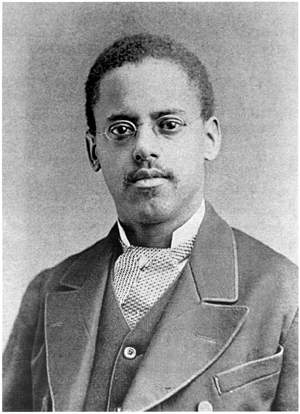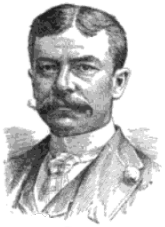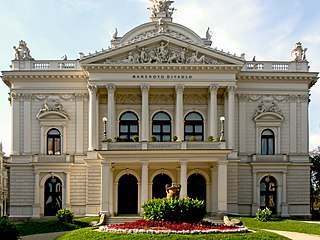
Thomas Alva Edison was an American inventor and businessman. He developed many devices in fields such as electric power generation, mass communication, sound recording, and motion pictures. These inventions, which include the phonograph, the motion picture camera, and early versions of the electric light bulb, have had a widespread impact on the modern industrialized world. He was one of the first inventors to apply the principles of organized science and teamwork to the process of invention, working with many researchers and employees. He established the first industrial research laboratory.
The ampere-turn is the MKS (metre–kilogram–second) unit of magnetomotive force (MMF), represented by a direct current of one ampere flowing in a single-turn loop. Turns refers to the winding number of an electrical conductor composing an electromagnetic coil. For example, a current of 2 A flowing through a coil of 10 turns produces an MMF of 20 A⋅t. The corresponding physical quantity is N⋅I, the product of the number of turns, N, and the current, I; it has been used in industry, specifically, US-based coil-making industries.

The war of the currents was a series of events surrounding the introduction of competing electric power transmission systems in the late 1880s and early 1890s. It grew out of two lighting systems developed in the late 1870s and early 1880s; arc lamp street lighting running on high-voltage alternating current (AC), and large-scale low-voltage direct current (DC) indoor incandescent lighting being marketed by Thomas Edison's company. In 1886, the Edison system was faced with new competition: an alternating current system initially introduced by George Westinghouse's company that used transformers to step down from a high voltage so AC could be used for indoor lighting. Using high voltage allowed an AC system to transmit power over longer distances from more efficient large central generating stations. As the use of AC spread rapidly with other companies deploying their own systems, the Edison Electric Light Company claimed in early 1888 that high voltages used in an alternating current system were hazardous, and that the design was inferior to, and infringed on the patents behind, their direct current system.

Lewis Howard Latimer was an African American inventor and patent draftsman. His inventions included an evaporative air conditioner, an improved process for manufacturing carbon filaments for light bulbs, and an improved toilet system for railroad cars. In 1884, he joined the Edison Electric Light Company where he worked as a draftsman.

Edward Hibberd Johnson was an inventor and business associate of American inventor Thomas Alva Edison. He was involved in many of Edison's projects, and was a partner in an early organization which evolved into General Electric. When Johnson was Vice President of the Edison Electric Light Company, a predecessor of Con Edison, he created the first known electrically illuminated Christmas tree at his home in New York City in 1882. Edward H. Johnson became the Father of Electric Christmas Tree Lights.

Charles W. Batchelor was an inventor and close associate of American inventor Thomas Alva Edison during much of Edison's career. He was involved in some of the greatest inventions and technological developments in history.

Francis Robbins Upton was an American physicist and mathematician. Upton worked alongside Thomas Edison in the development of incandescent light bulbs, electric generators, and electric power distribution. He was the first president of the Edison Pioneers.

Etheric force is a term Thomas Edison coined to describe a phenomenon later understood as high frequency electromagnetic waves—effectively, radio. Edison believed it was the mysterious force that some believed pervaded the ether.
The Edison Pioneers was an organization composed of former employees of Thomas Edison who had worked with the inventor in his early years. Membership was limited to people who had worked closely with Edison before 1885. On February 11, 1918, the Edison Pioneers met for the first time, on the 71st birthday of Edison. There were 37 people at the first meeting. Edison himself was not present; it was announced he was "engaged in important government service". It was suspected he was working on a military project since World War I was still in progress. The organization had 100 members although in later years descendants of Edison Pioneers were also allowed membership.

SS Servia, also known as RMS Servia, was a successful transatlantic passenger and mail steamer of revolutionary design, built by J & G Thomson of Clydebank and launched in 1881. She was the first large ocean liner to be built of steel instead of iron, and the first Cunard ship to have an electric lighting installation.
The Sprengel pump is a vacuum pump that uses drops of mercury falling through a small-bore capillary tube to trap air from the system to be evacuated. It was invented by Hanover-born chemist Hermann Sprengel in 1865 while he was working in London. The pump created the highest vacuum achievable at that time, less than 1 μPa.

The phonomotor or "vocal engine" was a device invented by Thomas Edison in 1878 to measure the mechanical force of sound. It converted sound energy or sound power into rotary motion which could drive a machine such as a small saw or drill. It derived from his work on the telephone and phonograph.

René Thury was a Swiss pioneer in electrical engineering. He was known for his work with high voltage direct current electricity transmission and was known in the professional world as the "King of DC."
John Roach & Sons was a major 19th-century American shipbuilding and manufacturing firm founded in 1864 by Irish-American immigrant John Roach. Between 1871 and 1885, the company was the largest shipbuilding firm in the United States, building more iron ships than its next two major competitors combined. It was also by far the largest contractor to the U.S. Navy during this period, and at its peak is said to have been the nation's largest employer behind the railroads.

Mahen Theatre is a Czech theatre situated in the city of Brno. Mahen Theatre, built as German Deutsches Stadttheater in 1882, was one of the first public buildings in the world lit entirely by electric light. It was built in a combination of Neo-renaissance, Neo-baroque and Neoclassical architectural styles.

The Edison State Park is located in the Menlo Park section of Edison, New Jersey. It is located on Christie Street, the first street in the world to be lit up by lightbulb, just off Lincoln Highway, near the Metropark Train Station. It covers a total area of 37 acres (0.15 km2). The park commemorates the site where the famous inventor Thomas Alva Edison had his Menlo Park laboratory. In his laboratory, Edison invented over 600 inventions such as the incandescent electric light and the phonograph, the latter being the first object to record and play sound.

Johann Sigmund Schuckert was an electrical engineer and the founder of Schuckert & Co.. He was a pioneer of industrialization in Nuremberg and for the electrical industry a pioneer of international status.

SS Oregon (1878–1906) was a coastal passenger/cargo ship constructed in Chester, Pennsylvania by the Delaware River Iron Ship Building and Engine Works in February 1878. Originally delivered to the Oregon Steamship Company, she was used on the Portland, Oregon-to-San Francisco, California route for many years. In 1879, the Oregon Railroad and Navigation Company became the Oregon′s new owners after purchasing the Oregon Steamship Company. Also included in this purchase were the steamships George W. Elder and City of Chester. While in O.R. & N service, Oregon served alongside SS Columbia, which made the first commercial use of Thomas Edison's incandescent light bulb. Like Oregon, Columbia was also built by John Roach & Sons in Chester, Pennsylvania. Over time, Oregon's hull became breached after a number of incidents. Furthermore, the hull had been weighted with concrete to the point where she was considered unsuitable for service as a passenger liner. After operating as a cargo ship, she was laid up in 1894 at Portland. In 1899, the Oregon was re-qualified to carry passengers once more. She was sold by O.R. & N the same year. Despite this, she was viewed as a cursed ship by her crew. On 26 December 1889 she sank Clan McKenzie in a collision in snow in the Columbia River at Coffee Rock 47 miles above Astoria, Oregon. Two of Clan McKenzie's crew killed, one injured. Her bow was damaged and she drifted ashore, later pulled off.














